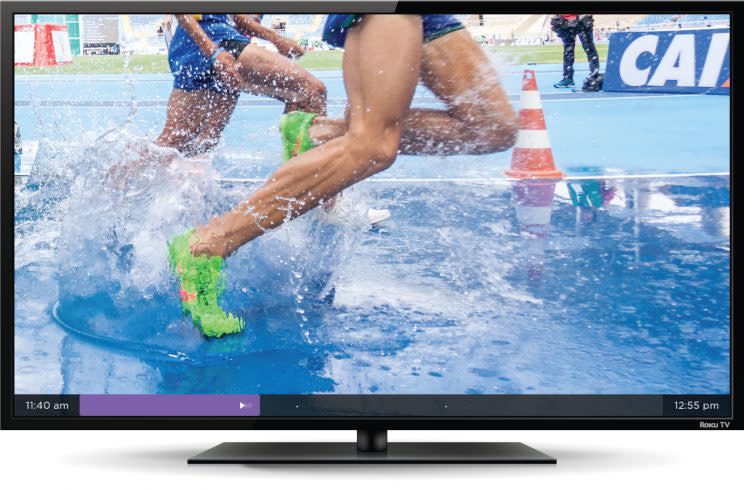Roku’s new pause button turns your TV into a poor man’s DVR

The next software update from Roku for TVs running the company’s media-player software contains something more exciting than the usual “bug fixes and performance improvements”: a pause button for broadcast television.
It would be a stretch to say this “Live TV Pause” feature will make a Roku TV a TiVo. But users will find themselves with the cheapest poor man’s DVR yet, requiring no additional investment beyond a USB flash drive with 16GB or more of storage — which will cost you about $5 and change these days. Unfortunately, the feature doesn’t work with cable or satellite TV, just your average over-the-air broadcasters.
Roku’s new feature invites two questions: Shouldn’t this have happened a while ago? And why doesn’t this also let you put cable or satellite TV on hold while you hit the restroom or grab a beer?
Why only now?
Live TV Pause, which will let you freeze a broadcast for up to 90 minutes on Ruku TVs (but not Roku’s standalone players), doesn’t exactly represent a breakthrough innovation. Pausing live video and letting it buffer to a storage device, like a USB stick or hard drive, is Streaming Video 101.
And yet “smart TVs” that ship with the ability to play and pause video from dozens of streaming services haven’t offered the same option for broadcast TV channels.
So if you just want to pause a live cable or satellite program, you have to get a full-fledged DVR. Historically, that’s been an expensive proposition: Either you pay $20 or so a month to your cable or satellite provider to rent its DVR, or you buy a TiVo (TIVO) for $200 or more and an additional $15 a month in service fees.
(The market for DVRs might be a little more diverse had TiVo not sued so many other firms for allegedly infringing broad patents on time-shifting video — a campaign that, it said in a 2015 filing, had yielded more than $1.6 billion in court awards and licensing payments.)
Roku’s pause-only feature is unlikely to deter potential TiVo buyers already eyeing its 4K-capable Bolt DVR or cheaper, broadcast-only DVRs like TiVo’s $399, lifetime-service-included Roamio and Channel Master’s $249 fee-free DVR.
But most TVs that ship with Roku’s software — an increasingly important part of its business— aren’t aimed at the high-end market anyway. They provide a good value to budget-minded shoppers, and they’ve drawn praise from the likes of Consumer Reports and the Wirecutter. This new software update makes those sets a little more attractive for essentially free.
So even if this pause button seems like an overdue addition, give Roku credit for making it happen when nobody else has.
“That’s still relatively new in the grand scheme of Roku’s history, compared with how long its streaming boxes have been around,” observed analyst Jan Dawson, founder of Jackdaw Research. To be exact, Roku shipped its first, Netflix-only player eight years ago.
Cable can complicate things
Obviously, the strangest part of this Roku update — which will also expand existing support for sharing photos and entire screens from mobile devices — is its broadcast-only limitation. At the basic level of pausing a live feed, video is video; it shouldn’t matter whether it comes in over an antenna or via cable or satellite.
As Dawson mused: “In theory you’d assume that any input could be captured and recorded in the same way.”
But the over-the-air tuner comes built into a Roku TV. A cable or satellite signal has to arrive from an external box that, again, you pay to rent from your cable or satellite provider. Meanwhile, Roku has been courting cable providers to have them ship apps for its platform that allow box-free viewing of a pay-TV lineup of channels — so monkeying with the output of its existing boxes might lead to some awkward moments between the company and cable providers.
Roku’s early success in getting Comcast and Charter on board put it in a good spot to benefit from the cable industry’s “Ditch the Box” commitment to ship apps for media players like Roku’s. That may, in turn, help explain why Roku has opposed the Federal Communications Commission’s proposal to write regulations requiring cable and satellite operators to ship free apps for viewing and recording TV.
Roku’s response to a question about the broadcast-only limit of this pause feature was to note the diversity of its cable partnerships, both in the US and abroad.
If you look at the pay-TV business as a political space, this all makes sense. But this also serves as another illustration of how paying for TV can leave you fewer viewing options than putting up an antenna and picking it up for free.
More from Rob:
Hackers are taking over your smart devices, here’s how we can stop them
How hackers could use your smart home devices to launch web attacks
How the government plans to make your self-driving car safer
Email Rob at rob@robpegoraro.com; follow him on Twitter at @robpegoraro.


